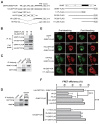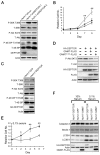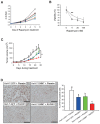Functional characterization of glycine N-methyltransferase and its interactive protein DEPDC6/DEPTOR in hepatocellular carcinoma
- PMID: 22160218
- PMCID: PMC3324955
- DOI: 10.2119/molmed.2011.00331
Functional characterization of glycine N-methyltransferase and its interactive protein DEPDC6/DEPTOR in hepatocellular carcinoma
Erratum in
- Mol Med. 2012;18(1):546
Abstract
Glycine N-methyltransferase (GNMT) is a tumor suppressor for hepatocellular carcinoma (HCC). High rates of Gnmt knockout mice developed HCC. Epigenetic alteration and dysregulation of several pathways including wingless-type MMTV integration site (Wnt), mitogen-activated protein kinase (MAPK) and Janus kinase and signal transducer and activator of transcription (JAK-STAT) are associated with HCC development in Gnmt knockout mice. We hypothesized that GNMT may regulate signal transduction through interacting with other proteins directly. In this report, we identified a mammalian target of rapamycin (mTOR) inhibitor (DEP domain containing MTOR-interacting protein [DEPDC6/DEPTOR]) as a GNMT-binding protein by using yeast two-hybrid screening. Fluorescence resonance energy transfer assay demonstrated that the C-terminal half of GNMT interact with the PSD-95/Dlg1/ZO-1 (PDZ) domain of DEPDC6/DEPTOR. Immunohistochemical staining showed that 27.5% (14/51) of HCC patients had higher expression levels of DEPDC6/DEPTOR in the tumorous tissues than in tumor-adjacent tissues, especially among HCC patients with hepatitis B viral infection (odds ratio 10.3, 95% confidence interval [CI] 1.05-11.3) or patients with poor prognosis (death hazard ratio 4.51, 95% CI 1.60-12.7). In terms of molecular mechanism, knockdown of DEPDC6/DEPTOR expression in HuH-7 cells caused S6K and 4E-BP activation, but suppressed Akt. Overexpression of DEPDC6/DEPTOR activated Akt and increased survival of HCC cells. Overexpression of GNMT caused activation of mTOR/raptor downstream signaling and delayed G2/M cell cycle progression, which altogether resulted in cellular senescence. Furthermore, GNMT reduced proliferation of HuH-7 cells and sensitized them to rapamycin treatment both in vitro and in vivo. In conclusion, GNMT regulates HCC growth in part through interacting with DEPDC6/DEPTOR and modulating mTOR/raptor signaling pathway. Both GNMT and DEPDC6/DEPTOR are potential targets for developing therapeutics for HCC.
Figures





 , HuH-7-GFP + 4;
, HuH-7-GFP + 4;
 , HuH-7-GFP + 20;
, HuH-7-GFP + 20;
 , HuH-7-GFP + 100; ●, HuH-7-GNMT + 0;
, HuH-7-GFP + 100; ●, HuH-7-GNMT + 0;
 , HuH-7-GNMT + 4;
, HuH-7-GNMT + 4;
 , HuH-7-GNMT + 20;
, HuH-7-GNMT + 20;
 , HuH-7-GNMT + 100; panel B: —○—, HuH-7-GFP; ---●---, HuH-7-GNMT; panel C: —○—, HuH-7-GFP + placebo;
, HuH-7-GNMT + 100; panel B: —○—, HuH-7-GFP; ---●---, HuH-7-GNMT; panel C: —○—, HuH-7-GFP + placebo;
 , HuH-7-GFP + RAD001;
, HuH-7-GFP + RAD001;
 , HuH-7-GNMT + placebo;
, HuH-7-GNMT + placebo;
 , HuH-7-GNMT + RAD001.
, HuH-7-GNMT + RAD001.Similar articles
-
Characterization of the GNMT-HectH9-PREX2 tripartite relationship in the pathogenesis of hepatocellular carcinoma.Int J Cancer. 2017 May 15;140(10):2284-2297. doi: 10.1002/ijc.30652. Int J Cancer. 2017. PMID: 28205209
-
DEPTOR induces a partial epithelial-to-mesenchymal transition and metastasis via autocrine TGFβ1 signaling and is associated with poor prognosis in hepatocellular carcinoma.J Exp Clin Cancer Res. 2019 Jun 22;38(1):273. doi: 10.1186/s13046-019-1220-1. J Exp Clin Cancer Res. 2019. PMID: 31228948 Free PMC article.
-
Loss of the glycine N-methyltransferase gene leads to steatosis and hepatocellular carcinoma in mice.Hepatology. 2008 Apr;47(4):1191-9. doi: 10.1002/hep.22159. Hepatology. 2008. PMID: 18318442 Free PMC article.
-
Pleiotropic effects of methionine adenosyltransferases deregulation as determinants of liver cancer progression and prognosis.J Hepatol. 2013 Oct;59(4):830-41. doi: 10.1016/j.jhep.2013.04.031. Epub 2013 May 7. J Hepatol. 2013. PMID: 23665184 Review.
-
The multi-functional roles of GNMT in toxicology and cancer.Toxicol Appl Pharmacol. 2013 Jan 1;266(1):67-75. doi: 10.1016/j.taap.2012.11.003. Epub 2012 Nov 10. Toxicol Appl Pharmacol. 2013. PMID: 23147572 Review.
Cited by
-
DEPTOR regulates vascular endothelial cell activation and proinflammatory and angiogenic responses.Blood. 2013 Sep 5;122(10):1833-42. doi: 10.1182/blood-2013-03-488486. Epub 2013 Jul 23. Blood. 2013. PMID: 23881914 Free PMC article.
-
Characterization and identification of PARM-1 as a new potential oncogene.Mol Cancer. 2013 Jul 31;12:84. doi: 10.1186/1476-4598-12-84. Mol Cancer. 2013. PMID: 23902727 Free PMC article.
-
Somatic mutations of PREX2 gene in patients with hepatocellular carcinoma.Sci Rep. 2019 Feb 22;9(1):2552. doi: 10.1038/s41598-018-36810-5. Sci Rep. 2019. PMID: 30796242 Free PMC article.
-
Prognostic and clinicopathological significance of DEPTOR expression in cancer patients: a meta-analysis.Onco Targets Ther. 2018 Aug 22;11:5083-5092. doi: 10.2147/OTT.S167355. eCollection 2018. Onco Targets Ther. 2018. PMID: 30174446 Free PMC article.
-
Folic Acid Ameliorates Renal Injury in Experimental Obstructive Nephropathy: Role of Glycine N-Methyltransferase.Int J Mol Sci. 2023 Apr 6;24(7):6859. doi: 10.3390/ijms24076859. Int J Mol Sci. 2023. PMID: 37047834 Free PMC article.
References
-
- El-Serag HB, Rudolph KL. Hepatocellular carcinoma: epidemiology and molecular carcinogenesis. Gastroenterology. 2007;132:2557–76. - PubMed
-
- Finn RS. Development of molecularly targeted therapies in hepatocellular carcinoma: where do we go now? Clin Cancer Res. 2010;16:390–7. - PubMed
-
- Sahin F, et al. mTOR and P70 S6 kinase expression in primary liver neoplasms. Clin Cancer Res. 2004;10:8421–5. - PubMed
Publication types
MeSH terms
Substances
LinkOut - more resources
Full Text Sources
Medical
Miscellaneous

